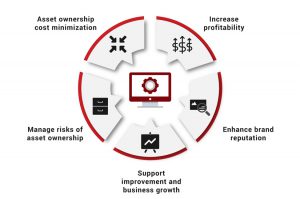Is Your Asset Management Tracking Compliant?
Nobody ever builds a asset management platform from scratch. More than likely, you inherited a system — and it’s desperately in need of an overhaul. Processes and activities are probably not aligned, documentation was not being completed, and cross-team communication across most divisions was broken. The point of the asset management system is to create a transparent audit trail for your computer equipment and other physical assets, helping your company mitigate risks (asset loss) and improve planning, especially when it comes to capital expenditures (such as when to perform upgrades on older laptops and desktop machines).
Ultimately, the goal is to get the most out of your assets, to have a clear picture of what is working, and what needs to be “retired.”

PECB ISO 55001 Asset Management Training
Do you have a transparent process?
Healthy asset management means ensuring your organization is able to realize the full benefit of its investments, whether physical, financial, human, or intangible assets. It’s about maximizing value while also meeting stakeholder expectations. Asset management standards, such as ISO 55001, provide a structured framework to manage the lifecycle of your assets, from acquisition through decommissioning. But how you execute those standards, and align them with your unique business requirements, could mean the difference between success and failure.
The platform for capturing / documenting your assets is important, but secondary to the needs of your business. Both SharePoint on-premises and Microsoft 365 (SharePoint Online) support various out-of-the-box and 3rd party asset management solutions. A quick search for “SharePoint asset management” will provide you with dozens of options for templates and tools. The most important aspect of whatever technical solution you put in place is to have a detailed framework or methodology in place to manage your process, including regular audits of your assets.
Quickly organize, find opportunities to improve
Starting with the ISO 55001 framework, you should be able to input your organizational policies and procedures, and quickly identify areas where your company’s asset management activities are falling short. You then need to map out the appropriate roles and departmental responsibilities, and develop a training needs assessment for your staff.
Creating an asset management roadmap will enable you and your team to gain deeper insights into your asset lifecycle, and incorporate this learning into the regular governance board review cycle.
Develop a structured, best practice approach

Photo by Alejandro Escamilla on Unsplash
No single asset management standard will fit the need of every business, but struggling with visibility over what is required and what procedures are being followed makes the job even harder. The fundamental issue here is governance: it is critical that you maintain some level of oversight of your standards, and work with teams and business units across your organization to develop consistent, prioritized, and auditable risk management policies to help you maintain your asset lifecycle.
Documenting your asset management roadmap will give your organization visibility and flexibility in managing what can otherwise be a very complex process, especially within a large organization. It is critical that you clarify roles and responsibilities, and leverage your governance board or committee to keep complex business processes organized and transparent. Having a documented roadmap:
- Ensures compliance to key processes and procedures, and alignment with industry standards
- Improves the knowledge sharing and training of staff and internal auditors
- Allows for functional and process gap analysis as part of a regular audit process
- Provides a platform for managing frameworks, such as ISO 55001, and a process of continual improvement




